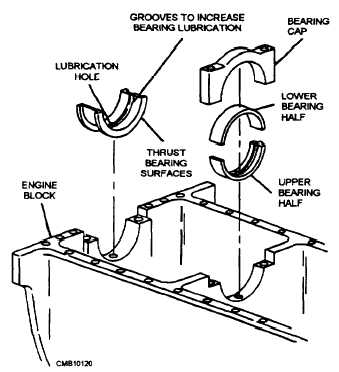sleeve that fits around the rotating journal or shaft (fig. 3-68). Connecting rod or camshaft (main) bearings are of the split or half type (fig. 3-69). On main bearings, the upper half is installed in the counterbore in the cylinder block. The lower-bearing half is held in place by the bearing cap (fig. 3-70). On connecting rod bearings, the upper-bearing half is installed in the rod and the lower half is placed in the rod cap. The piston pin bearing in the connecting rod is of the full round or bushing type.
Bearing Lubrication
The lubrication of bearings is very important to engine service life because it forces oil to high friction points within the engine. Without lubrication between parts, bearings overheat and score from friction.
The journal or shaft must be smaller in diameter than the bearing (fig. 3-71), so there is clearance (called oil clearance) between the two parts; oil circulates through the clearance. The oil enters through the oil hole (fig. 3-66) and fills the oil groove in the bearing. From there, the rotating journal carries the oil around to all moving parts of the bearing. The oil works its way to the outer edges of the bearing. From there, it is thrown off and drops back into the oil pan. The oil thrown off helps to lubricate other engine parts, such as the cylinder walls, the pistons, and the piston rings.

Figure 3-69. - Crankshaft main bearings.

Figure 3-70. - Connecting rod bearings.
As the oil moves across the faces of the bearings, it not only lubricates them but also helps keep them cool. The oil is relatively cool, as it leaves the oil pan. It picks up heat in its passage through the bearing. This heat is

Figure 3-71. - Oil clearance between bearing and shaft.
Continue Reading